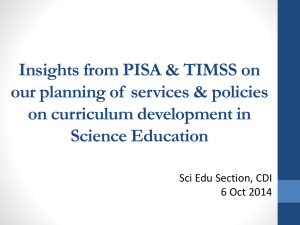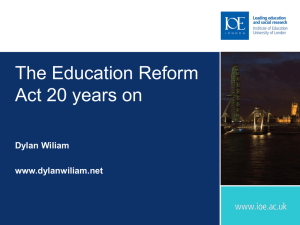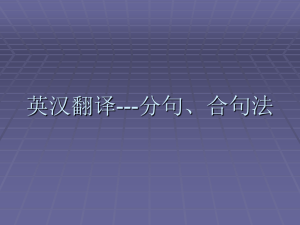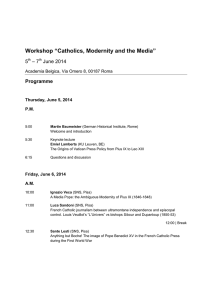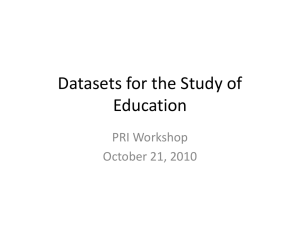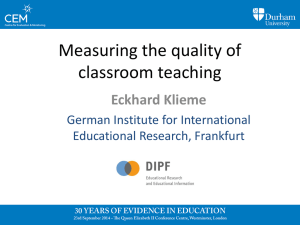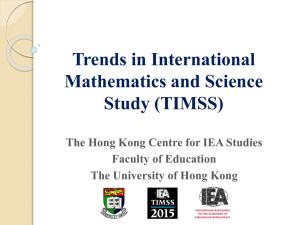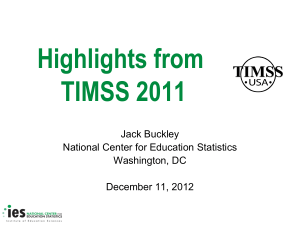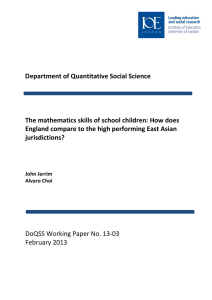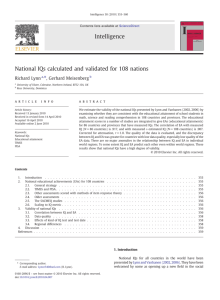***** 1 - Центр оценки качества образования
advertisement
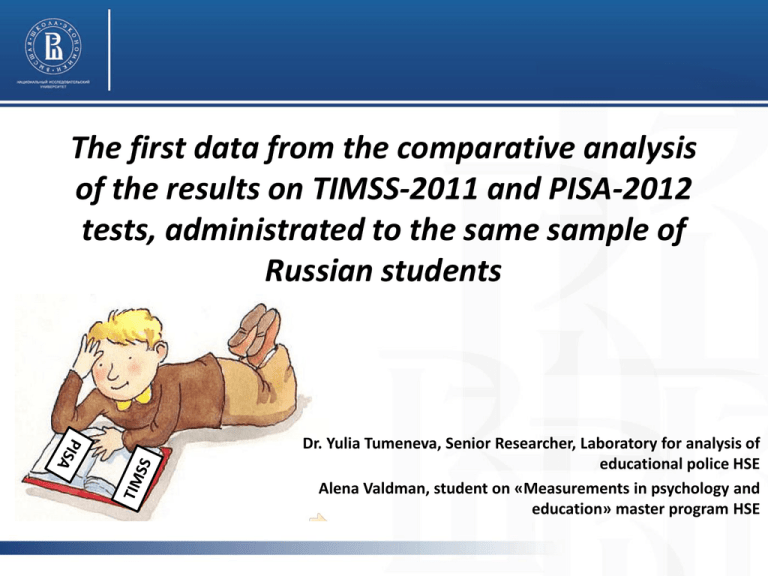
The first data from the comparative analysis of the results on TIMSS-2011 and PISA-2012 tests, administrated to the same sample of Russian students Dr. Yulia Tumeneva, Senior Researcher, Laboratory for analysis of educational police HSE Alena Valdman, student on «Measurements in psychology and education» master program HSE Research question How knowledge and skills measured in TIMSS associate with the skills measured in PISA? Russian sample (TIMSS-2011/PISA-2012) Sample TIMSS-2011: 4893 pupils from 229 classes (49,3% girls and 50,7% boys) Sample PISA-2012: 4399 pupils from 229 classes (49,6% girls and 50,4% boys) Strategy of analysis • Divide TIMSS classes into 6 groups from the top performers to poor performers • Pick up 10 and 20 hardest PISA items • Check what is the percent of the ten (and 20) hardest PISA items each TIMSS group did correctly How have we divided the sample? 229 classes in TIMSS 1 2 35 classes 39 classes 15,3% 3 4 5 39 classes 39 classes 17,0% The classes have highest PVs math 17,0% 17,0% 6 39 classes 38 classes 17,0% 16,6% The classes have lowest PVs math Hardest items PISA. How to reach them? One-Parameter Rasch Model (Partial-Сredit ) The difficulty of each tasks in the PISA in logits Selection of 10 (20) of the most difficult tasks PISA (highest logits) Results: mathematics % correct items of 10 hardest items in each group % correct items of 20 hardest items in each group 27.48 Only highly developed “TIMSS” skills differentiate success in PISA 19.15 15.64 13.55 9.11 10.02 8.10 6.37 9.92 6.06 5.31 3.20 TIMSS classes with highest PV math 2 3 4 5 TIMSS classes with lowest PV math Results: content domains % correct items of 10 hardest items in each group № group Algebra Data and chance Number Geometry 1 3 17,76 10,84 7,07 17,89 9,91 6,80 18,31 10,28 7,45 18,20 11,23 6,72 4 7,41 6,28 7,11 7,67 5 6,17 7,12 5,73 5,47 6 2,84 3,43 3,08 3,17 2 The same situation. Results: cognitive domains % correct items of 10 hardest items in each group № group Knowing Applying Reasoning 1 2 18,82 9,85 18,03 10,10 18,25 10,64 3 6,97 8,04 7,45 4 5,95 5,40 6,50 5 7,44 7,51 6,21 6 2,88 2,87 3,07 The same situation. What we talk about when we talk about hardest PISA items • To associate information presented in different ways • To keep relationships between things (or concepts) through time • To use information from one domain to solve a problem in another domain • To model relationships and changes mathematically Some preliminary conclusions In terms of PISA and TIMSS tests we can say that “TIMSS” skills very weakly differentiate “PISA” skills. Factually only highest level of mastery of TIMSS skills enable success in PISA BUT! We can consider TIMSS skills as mastery of subject content; PISA skills as ability to transfer knowledge from one domain to another. Then our results mean that only highest level of mastery of subject content enables the meta-domain transition. Future ways of analysis • To check these results on individual level • To check how overall TIMSS success can affect solving the hardest TIMSS items • To specify what TIMSS domain/items/cognitive process affect success in different PISA domain/items/cognitive process • To define other cognitive abilities, except subject knowledge, (e.g. analogical thinking) that can affect meta-domain transferring Thank you for your attention! Questions? Comments? Suggestions? Main references •Алейникова И., Нечего на зеркало пенять, коли школа стара // Управление школой, № 05, 2005 •Ковалева Г.С., Особенности проведения международного исследования PISA-2012 в регионах России, доклад, 2012 (2) •Пушникова Г. А зачем нам TIMSS и PISA? // Учительская газета, №6 , 2006 •РОСРО. Материалы дискуссии о конкурентоспособности российского образования // Вопросы образования, 2005, № 1. С. 235-263. •Тюменева Ю.А., Хавенсон Т.Е.. // Тенденции развития образования: проблемы управления и оценки качества. •Материалы 8 международной научно-практической конференции, Москва: Дело, 2012 (1) •Falch T., Rønning M. (2011). Homework assignment and student achievement in OECD countries . Working Paper Series, Norwegian University of Science and Technology, №5 •Goldhaber D. (2002). The mystery of good teaching: Surveying the evidence on student achievement and teachers’ characteristics. Education next 2(1) •Huang Francis L. & Moon Tonya R. (2009). Is experience the best teacher? A multilevel analysis of teacher characteristics and student achievement in low performing schools. Educ Asse Eval Acc, 21, P. 209–234 •Hutchison D., Schagen, I. In Loveless, T. (Eds.), (2007). Lessons Learned: What International Assessments Tell Us About Math Achievement. •Neidorf T, Binkley M., Gattis K., Nohara D. (2006). Comparing Mathematics Content in the National Assessment of Educational Progress (NAEP), Trends in International Mathematics and Science Study (TIMSS), and Program for International Student Assessment (PISA) 2003 Assessments // Technical Report •Washington, D.C.: Brookings Institute Press •Rindermann H. (2007) The g-Factor of International Cognitive Ability Comparisons: The Homogeneity of Results in PISA,TIMSS, PIRLS and IQ-Tests Across Nations. European Journal of Personality Eur. J. Pers. 21: P. 667–706 •Torney-Purta J., Richardson W. K., Barber C. H. (2005). Teachers’ Educational Experience And Confidence In Relation To Students’ Civic Knowledge Across Countries. International Journal of Citizenship and Teacher Education, Vol. 1, No. 1 •Wu, M. (2009). A comparison of PISA and TIMSS 2003 achievement results in mathematics. Prospects, 39: P.33–46 (1) •Wu, M. (2009). A. A Critical Comparison of the Contents of PISA and TIMSS Mathematics Assessments (2) •Wu, M. (2010). Comparing the Similarities and Differences of PISA 2003 and TIMSS. OECD Education Working Papers. No. 32. OECD Publishing •Zuzovsky R. (2009). Teachers’ qualifications and their impact on student achievement: Findings from TIMSS 2003 data for Israel. IERI Monograph Series. Issues and Methodologies in Large-Scale Assessments, Vol.2, P. 37-62
